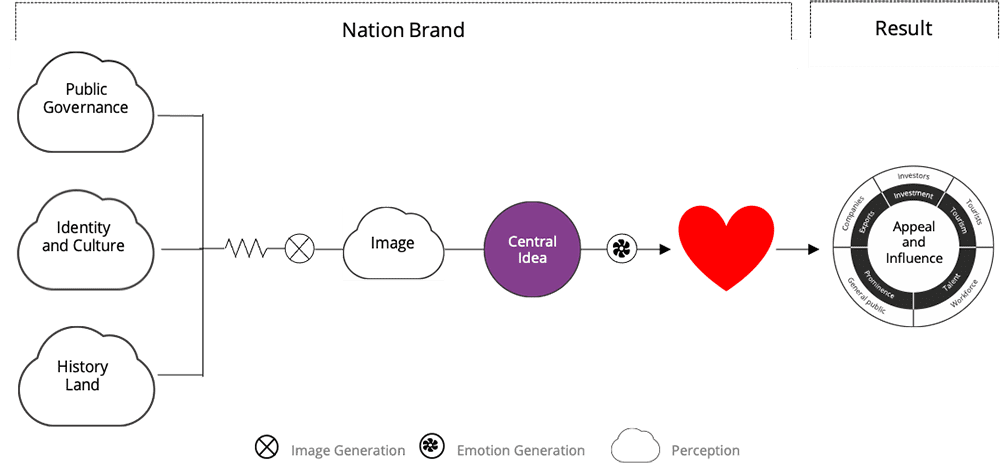Introduction
Whether the result of a natural or man-made shock to the system, crises and emergency situations will always arise and have the power to impact perceptions of a country, region or city. No matter the instance, how it started or how it ended, crisis management is a huge contributor in managing a Nation and Place Brand.
To begin, we’ll need to understand where perceptions form and the level of impact they can have on the brand. Then, we will provide five recommendations on how to mitigate the risks of lasting negative perceptions resulting from poorly perceived crisis response and management.
Perception formation process
Segment of Bloom Consulting Nation and Place Brand Circuit©

As seen in the segment above of the Bloom Consulting Nation and Place Brand Circuit©, the brand of a country, region or city is built over time through perceptions. These perceptions are centred around three areas or dimensions of a place’s existence:
- Public governance: perceptions of the place’s political system, the government and its management of national, regional, or local affairs, and of how it affects local and/or international citizens
- Identity and culture: perceptions of the place’s people as a whole and its association with shared characteristics, beliefs and customs, as well of existing social and cultural norms
- History and land: perceptions of the country’s past and present as well as its perceived place in the world and its physical characteristics such as its geography, nature, climate, natural resources, etc.
The way that these three areas are perceived independently or combined, generate the place’s overall image in audiences’ minds. Personal image associations then lead to what we call in Nation and Place Brand strategy, the Central Idea. Central Idea can be translated to the emotional link or the way people relate to and feel about that place, its government, its people, its businesses, and so forth. Ultimately, this emotion has the power to impact the place’s appeal and influence and thus its capacity to:
- Attract tourism
- Facilitate foreign direct investment
- Attract talent
- Foster exports (country-of-origin effect)
- Improve the country’s prominence (overall reputation)
Crises and factors that impact perceptions, Nation and Place Brands
Crisis situations, such as financial crises or economic meltdowns, natural disasters, health emergencies, corporate or technological crises, terrorist attacks, riots, civil strife, coup d’états and armed conflicts (to name a few), may immediately and/or for as long as the crisis persists, affect perceptions of a country, region or city. In some cases, these negative perceptions can even lead to damage being done to the place’s overall image and thus its brand over time.
This will depend on the Nation or Place Brand’s strength and resilience yes, but also on other factors. Based on our research, we at Bloom Consulting know that for Nation and Place Brands to be permanently and severely impacted by crisis situations any of the below three points need to occur, altogether or independently:
Longevity: although media coverage is likely to decrease over time, perceptions related to a crisis are expected to live as long as the crisis persists. The longer a crisis lasts, higher are the chances of being perceived as a structural “problem” for the place and stick to the overall image in audiences’ minds.
Intensity: the more negative or destructive the outcome for a place and/or its international stakeholders, and the more difficult it appears to be to restore the situation, the more unwanted attention and/or international media coverage and scrutiny a place is likely to attract.
Perceptions of ‘Identity and Culture’: when poor crisis response and management is (somehow) accredited to the place’s people and their behaviour, the risk of place brand impact is greater compared to for instance perceptions of poor leadership or geographical conditions.
What role do Nation and Place Brand teams play during crisis situations?
Nation and Place Brand teams are the keepers of the brand and thus will be the ones to take action in terms of managing perceptions throughout difficult times. They are the ones who direct strategy and will need to lead brand damage mitigation alongside government, community groups, and/or in partnership with major private sector organisations.
As a unit, the Nation or Place Brand team and beyond must act in accordance with the Nation or Place Brand strategy. As part of devising a comprehensive Nation or Place Brand, Brand Builders will have already established appropriate message delivery tactics in terms of who, what, when, where, how, and why. A clear brand proposition is meant to be the guiding light during times of uncertainty, offering clarity as to priorities and actionable measures.
Finally, it is key to remember that Nation and Place Brand management must be done by doing, not just by saying and will thus require the input and collaborative effort of the entire “team”.
The five keys to unlocking crisis management for Nation and Place Branders
Here we will have a look at five main recommendations (or must haves) to Place Brand teams take into battle next time their place face a crisis situation with potential harm to its brand.
1) Create a Crisis Committee
Begin by creating a Crisis Committee with its primary function being stakeholder alignment. During these times of unrest and distrust (in some cases) it is going to be of the utmost importance to maintain a unified voice and a clear stream of communication, synchronizing the tone and message from those who lead the response and have greater exposure. Due diligence of the crisis committee includes creating and deploying strategic crisis management missions.
2) Monitor the impact
Actively monitor the impact of the crisis at hand as well as the success of measures being taking. The more you know about what you are dealing with and in some cases, how others are dealing with it (such is the case of COVID-19), there are lessons to be learned in the moment no matter how hectic times may be. Confidently relaying information to the public and relevant stakeholder groups is not only responsible and transparent but provides audiences with assurance that something is being done on their behalf.
3) Build partnerships
Effective responses and monitoring are performed through successful partnerships. During these instances, the Nation and Place Brand team can be called on for their experience in stakeholder engagement to bring together necessary parties, each bringing with them necessary and unique information and know-how. This is an important time to be seen as the go-to Nation and Place Branding institution responsible for taking ownership of place reputation during times of crisis through effective stakeholder engagement and management model.
4) Manage your Digital Identity
Major crises create a steady stream of negative content both online and in traditional media. Remember, online content is there to stay forever. If results show that a place is strongly correlated with a recent (or not so recent) crisis, this is damaging to the place’s perceived image in the minds of target audiences.
The best solution is to manage your Digital Identity by providing positive and interesting stories that people want to read and moreover will gain something from reading. Content in this case will act as a replacement for negative results or media, pushing down scrutinous material which is hindering the brand’s movement in the right direction.
Also, in assessing your Digital Identity, ask whether it portrays an accurate depiction of the post-crisis new reality. This may require replacing outdated photos and information pertaining to activities, people, landscapes, operational businesses, etc. Being aligned is equally important online as it is in person or by direct communication.
5) Collaborate with all stakeholders
Lastly, take the side of your people. This is a moment to raise them up and encourage them to inspire others. Hometown heroes and front-line figures are the stories that will uplift the community during times of darkness. Stakeholder engagement is not an exclusively top-down activity. Listen to the communities’ recommendations when applicable, what do they need, where are they hurting, how can you help? The best solutions are often found through collaboration, don’t leave out the majority when it comes to collaborating.
To learn more about the Bloom Consulting approach to understanding image crisis management, our study on COVID-19: The Impact on Nation Brands gives further insight into crisis management, perception impact and measurement.












